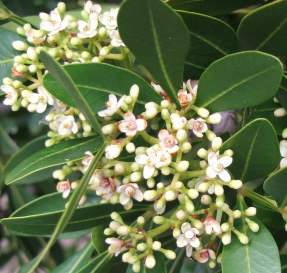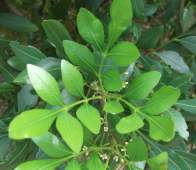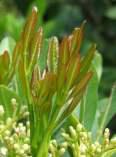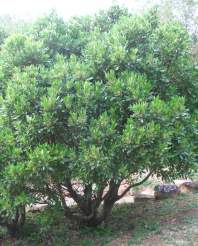Ekebergia pterophylla
Ekebergia pterophylla (C.DC) Hofmeyr
Family: Meliaceae
Common names: rock ash (Eng.); rotsessenhout (Afr.); maGwedla (Swahili)
SA Tree No: 299
Introduction
This is a tidy, attractive, evergreen shrub/tree, with sweetly scented flowers, bearing berries.

Description
Description
Sturdy shrub or small, evergreen tree with a flat crown and tidy habit, slow growing, from 2 to 5 m tall. The main stem is usually attractively gnarled, although in a sheltered position it will grow straighter, with light to dark grey bark that may often appear mottled.

The alternate, compound, blue-green leaves have one or two pairs of leaflets with a rounded terminal leaflet, but the most distinguishing characteristic is the broadly winged rachis and petiole.

The newly emerging leaves are tinged with pink and add to the attractiveness of the plant.

The small, sweetly scented flowers are borne in compact clusters from July to November. They are mainly white in colour but are also often tinged pink. The plants are dioecious, meaning unisexual, so male and female flowers occur separately on different plants. Small, fleshy, round, berry-like fruits are borne from February to May. They start out pale yellow and ripen through red to black — another feature that makes this plant attractive.
The rock ash can be confused with the tree jasmine, Schrebera alata. However, the leaves of the tree jasmine are arranged opposite not alternate like the rock ash; the tree jasmine's leaves are also hairy, whereas the rock ash has leathery leaves.
Distribution and habitat
Distribution description
Ekebergia pterophylla naturally occurs in montane and coastal forests, usually amongst rocks on outcrops or in ravines and on forest margins, from the Western Cape through to Mpumalanga and Limpopo, but mainly in KwaZulu-Natal and Pondoland as well as in Swaziland. It does well in gardens throughout South Africa, adjusting well to local climate, temperature and rainfall.
Derivation of name and historical aspects
History
The genus Ekebergia was named after Captain C.G. Ekeberg, whose sponsorship, in the 18th Century, made it possible for Anders Sparrman, the author of this tree species, to visit Africa. The specific name pterophylla means winged leaf. Although it is commonly called the rock ash, this tree is not related to the true ash species in the family Oleaceae.
E. pterophylla belongs to the mahogany family (Meliaceae). This is a large tropical and subtropical family of trees and shrubs. Some well-known members include red mahogany (Khaya anthotheca), African mahogany (Khaya senegalensis) and mahogany (Swietenia mahogani) This is a well-represented family with 51 genera and 800 species world-wide, many of which contain certain bitter tasting chemical compounds, some of which have insecticidal properties. It is also a very important tropical timber family. Ekebergia capensis is another species found in cultivation.
Ecology
Ecology
The rock ash's scented flowers attract bees and its fruits are enjoyed by birds. The plants are dioecious: the male and female flowers are on separate plants.
Uses
Use
It is a good ornamental garden tree with great potential as a bonsai subject.

Growing Ekebergia pterophylla
Grow
The plant is suitable as a slow-growing, specimen shrub in any garden but particularly suited to small gardens, as it does not get very big and it has such a neat habit. The clusters of scented flowers and yellow to red berries are what make this tree so ornamentally decorative and enjoyable, because between the long seasons of flowering and fruiting this shrub has something to offer almost all year long. It also makes a fantastic container plant, and would also be well placed amongst boulders, or in a rockery in a hot, sunny, exposed spot (as this is closest to its natural habitat), although it will tolerate light shade and a more protected aspect. If planted in an exposed situation in a windy coastal garden, it will most likely exhibit a wonderfully gnarled trunk. It is wind-tolerant, water-wise and will tolerate drought but as with most plants, will do well with consistent, if infrequent, watering, regular composting, and an occasional feed with a high nitrogen, organic or chemical fertilizer to boost its growth.
The rock ash is easily grown from seed sown in spring. Soak the berries in water for a day and then remove the flesh to expose the seeds. Sow seed in trays filled with potting soil, river sand or a mixture of compost and river sand (1:1). Plant no deeper than 5 mm. The seed should germinate within 4 to 8 weeks. Seedlings should only be transplanted after reaching the two-leaf stage.
The rock ash can also be grown from tip or hardwood cuttings taken in spring. These cuttings can be treated with a rooting hormone to help stimulate rooting. Pot into a well-drained potting mix once the cuttings have rooted and have hardened off.
References
- Coates Palgrave, M. 2002. Keith Coates Palgrave Trees of southern Africa, edn 3. Struik, Cape Town.
- Leistner, O.A. (ed.). 2000. Seeds plants of southern Africa: families and genera. Strelitzia 10. National Botanical Institute, Pretoria.
- Schmidt, E., Lötter, M. & McCleland, W. 2002. Trees and shrubs of Mpumalang and Kruger National Park. Jacana, Johannesburg.
Credits
Cherise Viljoen
Kirstenbosch Botanical Garden
November 2005
Plant Attributes:
Plant Type: Shrub, Tree
SA Distribution: Eastern Cape, KwaZulu-Natal, Limpopo, Mpumalanga, Western Cape
Soil type: Sandy, Clay, Loam
Flowering season: Spring, Early Summer, Winter
PH: Neutral
Flower colour: White, Pink
Aspect: Full Sun, Morning Sun (Semi Shade), Afternoon Sun (Semi Shade)
Gardening skill: Average
Special Features:
Horticultural zones










Rate this article
Article well written and informative
Rate this plant
Is this an interesting plant?
Login to add your Comment
Back to topNot registered yet? Click here to register.